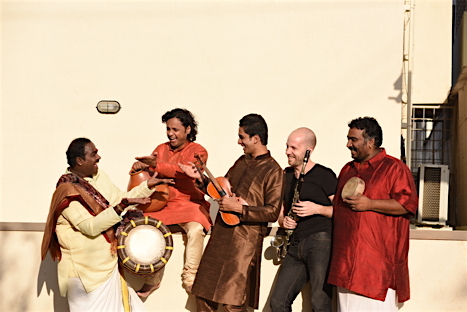Dieser Tage erscheint das schlicht “3″ betitelte dritte Album des heute als Quintett auftretenden indisch-polnischen Projektes Saagara auf dem Glitterbeat-Sublabel tak:til. Unter dem Bandnamen firmieren der von zahlreichen Kollaborationen bekannte und in vielen Musiksparten bewanderte in Warschau lebende Komponist und Mehrfachinstrumentalist Wacław Zimpel und das aus Giridhar Udupa (Ghatam), Aggu Baba (Khanjira), K Raja (Thavil) und Mysore N. Karthik (Violine) bestehende Instrumentalensemble. In der Zusammenführung aus klassischen und elektronischen Klangquellen knüpft “3″ an seine beiden Vorgänger an – neu dagegen ist der Fokus auf Rhythmik, die wie viele der Instrumente seine Wurzeln in indischen Musiktraditionen hat und in den Stücken mit experimentierfreudig umgesetzten Bauformen elektronischer Clubmusik verschmilzt. Das Album erscheint in den gängigen Formaten.
“The Saagara project was first initiated during a jam session in Poland more than a decade ago by Zimpel and one of the most prominent Indian percussionists Gitridhar Udupa (ghatam), and took further shape during his visit to India in 2012. With the 1976 album Shakti with John McLaughlin in mind, particularly its virtuosic blending of Western melodic-rhythmic concepts with Carnatic ones, Zimpel wanted to create something that would continue that ethos but with an individualized approach. His deep fascination with minimalism, tinged with electronics, helped shape the project’s concept as did the grooves and sounds of Carnatic music’s most prominent instruments. In Saagara, these instruments are played by the aforementioned Udupa, as well as Mysore N. Karthik on violin and Aggu Baba (khanjira) and K Raja (thavil) on percussion. Through the ensemble’s collective experimentation, the edgy rhythms of Carnatic music – one of India’s oldest musical traditions – became seamlessly synchronized with Zimpel’s clarinet and electronics and Karthik’s violin parts.
On 3 the music is not as contemplative as it was on the previous two albums. Acidic electronic post-club sounds now counterpoint the traditional instruments, and the instruments themselves are filtered through contemporary processing. [...] Saagara’s 3 is also more studio-based and conceptual. Zimpel devised electronic sequences and then got together in a Warsaw studio with Udupa, who began by adding konnakol (vocal percussion) rhythmic patterns to the sequences. Zimpel’s production grew from there – developing additional electronic textures, manipulating the sound of individual instruments, and deconstructing or reducing the instrument tracks altogether. [...] Saagara’s new album brings the ancient ritual of Carnatic music, a music that carries the listener from one state to another, into a dance with electronic music and its techniques, beats and synthesis. The whole thing unfolds in a cosmic trance; an inspired and buzzing juxtaposition of dense Indian rhythms with pulsating electronic patterns”. (Glitterbeat)
Foto: Rakesh Maiya

